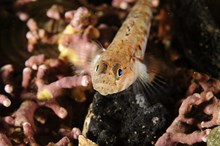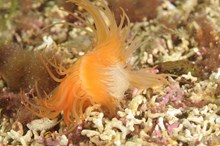27 December, 2017
Quarter of a billion flame shells find lights up Marine Protected Area
The world’s largest known colony of a brilliant but shy species of shellfish has been discovered in a west coast Marine Protected Area (MPA).
An eye-watering quarter of a billion flame shells have been found living in nests which have merged to form a huge 185 hectare bed at the bottom of Loch Carron. Flame shells are small bivalve molluscs with fiery orange tentacles. Flame shells spend most of their lives completely hidden away inside nests, built from old shells, stones and other materials around them and bound together with thin wiry threads.
The discovery was made during a joint Scottish Natural Heritage (SNH), Marine Scotland (MS) and Heriot-Watt University (HWU) survey to learn more about habitats in Loch Carron. The latest find further highlights the global importance of Scotland for the species, following on from a 2012 discovery in Loch Alsh of a colony of more than 100 million flame shells.
Mike Cantlay, SNH’s Chair, said: "Scotland’s Seas clearly still have many secrets left to tell. This is a remarkable discovery and I think we should be proud that our rich waters are so important to flame shells, and as our marine research and survey work continues to reveal, many other wonderful species too.”
Environment Secretary Roseanna Cunningham said: “This is a fantastic discovery which shows that the new Marine Protected Area is making an even more valuable contribution to safeguarding these waters than we first thought.
“I am determined to protect Scotland’s rich marine environment as this example shows the importance of considering how our seas are conserved beyond the MPA network. We are continuing to work with SNH to review the most vulnerable Priority Marine Features in our coastal waters.”
Dr Dan Harries, of Heriot-Watt University's Institute of Life & Earth Sciences which who led the diving fieldwork, said: "This is another fantastic discovery. We really didn’t think we’d find a bed that could top the 100,000,000 find in Loch Alsh. This is a great example of partnership working across Government departments, SNH and academia to deliver a timely and scientifically robust response.”
Ends
Notes to editors
- An MPA designated on an urgent basis lasts for a maximum of two years but the intention is to make Loch Carron a permanent MPA. A public consultation on making the site a permanent addition to the Scottish MPA network is anticipated in 2018.
- When announcing the designation, the Cabinet Secretary for Environment, Climate Change and Land Reform also announced a wider review of vulnerable habitats to identify where else management is needed to prevent further damage or loss.
- Flame shell beds support a very diverse community of other species. Targeted protection of this habitat-building species effectively conserves hundreds of other species and promotes local biodiversity.
- Flame shell beds are extremely sensitive to physical disturbance, such as dredging. Substantial and persistent declines have been observed raising widespread concern about the conservation of this species and habitat it creates.
- The 185 hectare flame shell bed covers much of the tide-swept seafloor of the Strome Narrows, from Craig to Stromeferry.
- Where flame shell nests group together in high numbers, the sea bed can be covered by a felt-like organic reef of material several centimetres thick.
- Flame shell beds have a globally restricted distribution. They are known primarily from the western coasts and lochs of Scotland. They have also been recorded in Mulroy Bay in County Donegal, Ireland and more recently in Orkney waters.
- Beds are currently known at 10 broad locations in Scotland, with six of these designated as MPAs.
Contact information
- Name
- Dominic Shann
- Job Title
- Media Relations Officer
- Telephone
- 01463 725157
- dominic.shann@nature.scot
NatureScot is Scotland's nature agency. We work to enhance our natural environment in Scotland and inspire everyone to care more about it. Our priority is a nature-rich future for Scotland and an effective response to the climate emergency. For more information, visit our website at www.nature.scot or follow us on X at https://x.com/NatureScot
’S e NatureScot buidheann nàdair na h-Alba. Bidh sinn a’ neartachadh àrainneachd na h-Alba agus a’ brosnachadh dhaoine gu barrachd suim a chur ann an nàdar. Tha e mar phrìomhachas againn gum bi nàdar na h-Alba beairteach agus gun dèilig sinn gu h-èifeachdach le èiginn na gnàth-shìde. Tha an tuilleadh fiosrachaidh aig www.nature.scot no air X aig https://x.com/NatureScot


